Cuttlefish
Sepiida
Found throughout the world's oceans!
Advertisement
Cuttlefish Scientific Classification
Read our Complete Guide to Classification of Animals.
Cuttlefish Conservation Status
Cuttlefish Facts
- Main Prey
- Crab, Shrimp, Fish
- Distinctive Feature
- Long body shape and large eyes
- Habitat
- Coastal and deeper waters
- Predators
- Fish, Sharks, Cuttlefish
- Diet
- Carnivore
- Average Litter Size
- 200
- Favorite Food
- Crab
- Common Name
- Cuttlefish
- Number Of Species
- 120
- Location
- Worldwide
- Slogan
- Found throughout the world's oceans!
View all of the Cuttlefish images!
Equipped with flexible tentacles, ink production capabilities, and a keen intelligence, the cuttlefish is a remarkable creature of the sea.
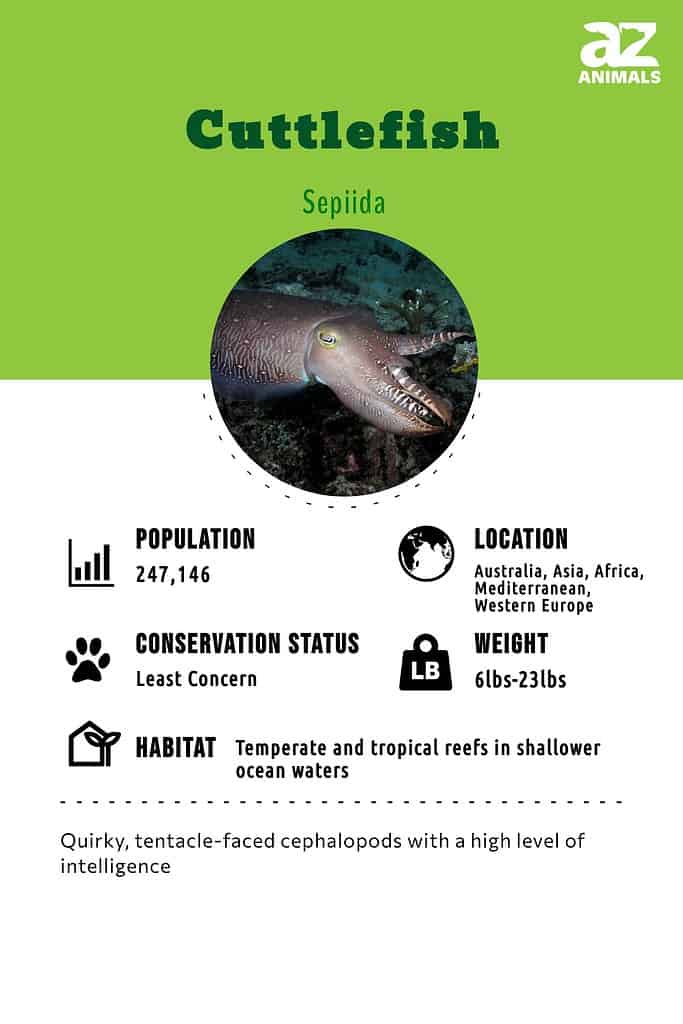
Despite the name, it is not really a fish at all, but a type of cephalopod. This puts it in the same class as the squid, nautilus, and octopus. It is often said that the cephalopods resemble aliens on Earth in the sense that it’s a remarkably intelligent but very different type of lifeform from us. They last shared a common ancestor with land animals some hundreds of millions of years ago.
5 Incredible Cuttlefish Facts
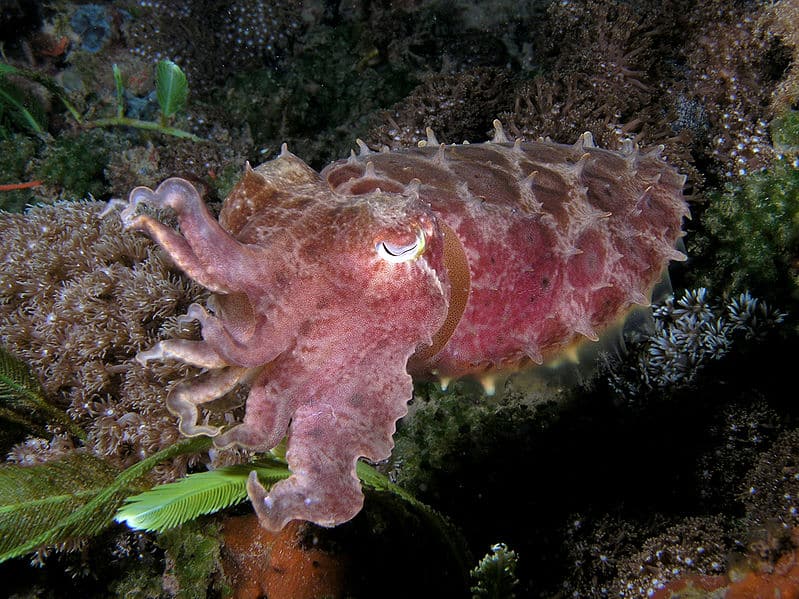
Cuttlefish are some of the most ancient living creatures of the sea.
- All cuttlefish feature a thick internal shell called a cuttlebone, from which the name obviously derives. The cuttlebone is composed of the mineral aragonite with calcium, carbon, and oxygen atoms.
- This creature evolved 21 million years ago in the Miocene Epoch. Its ancestor probably came from an extinct cephalopod order known as the belemnitida. Unlike many modern cephalopods, the belemnitida had a full skeleton.
- The ink of the cuttlefish has been used as both dye and medicine throughout human history.
- With its curvy W-shaped eye, this fish has the remarkable ability to perceive extremely high contrasts in light that is normally invisible to the human eye. Contrast is the difference between white and dark light. As a tradeoff, however, the cuttlefish is unable to see color.
- A few cuttlefish species are able to produce toxic venom to ward off predators.
Want more cuttlefish facts? Check out ‘10 Impressive Cuttlefish Facts‘ which has much more on their color changing and intelligence!
Scientific Name
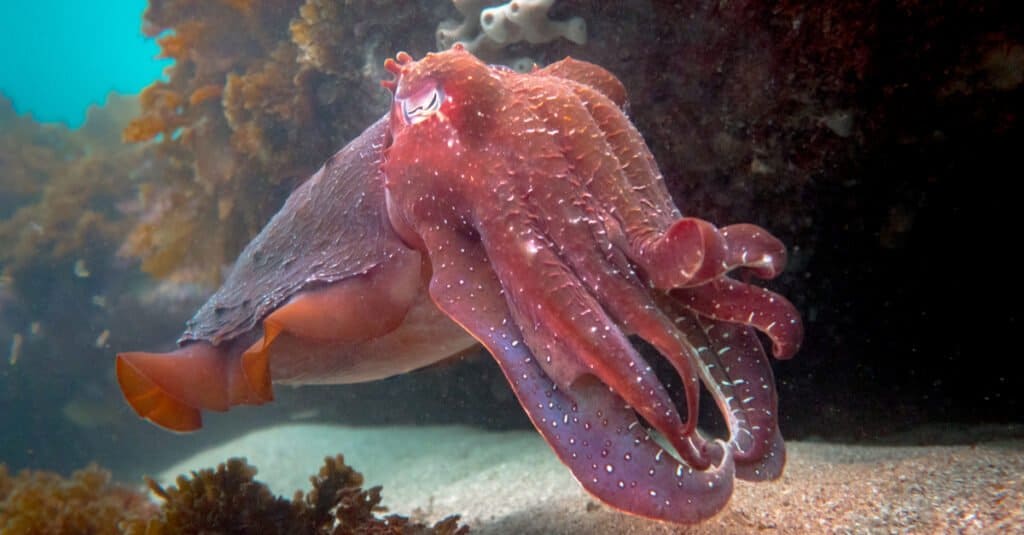
Not all Sepiida are sepia, many come in different vibrant colors.
©Ste Everington/Shutterstock.com
The scientific name of the cuttlefish is Sepiida, which refers to the entire order. The term Sepiida derives from the Greek and Latin word sepia, which is a reference to the name of the dye produced from its ink. Sepia is now the English word for a type of reddish-brown color.
Notable Species
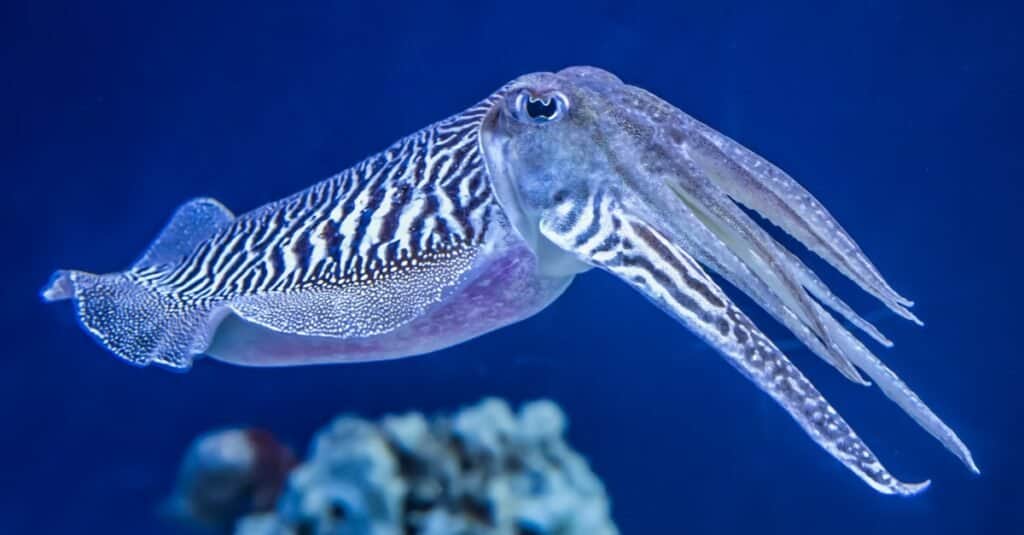
The Common Cuttlefish (Sepia officinalis) is generally found in the eastern North Atlantic and Mediterranean Sea.
©David A Litman/Shutterstock.com
There are approximately 120 species of cuttlefish still alive. Here is just a small sample of them:
- Common Cuttlefish: As the name implies, this is one of the most widespread species of cuttlefish in the world. Measuring no more than 19 inches in size, the common cuttlefish primarily inhabits the waters of the Mediterranean Sea, North Sea, and Baltic Sea.
- Pharaoh Cuttlefish: This is a large species of cuttlefish that inhabits the Pacific region between Japan and Australia and as far west as the Red Sea. It is commonly hunted in the Philippines, India, and Persia for food.
- Flamboyant Cuttlefish: This species is well-named for the rather bright and exuberant pattern of colors on its mantle. Endemic to the waters of Australia and Southeast Asia, this species produces an acid that makes it unsuitable for human consumption. This small species is only a few inches in length.
Evolution
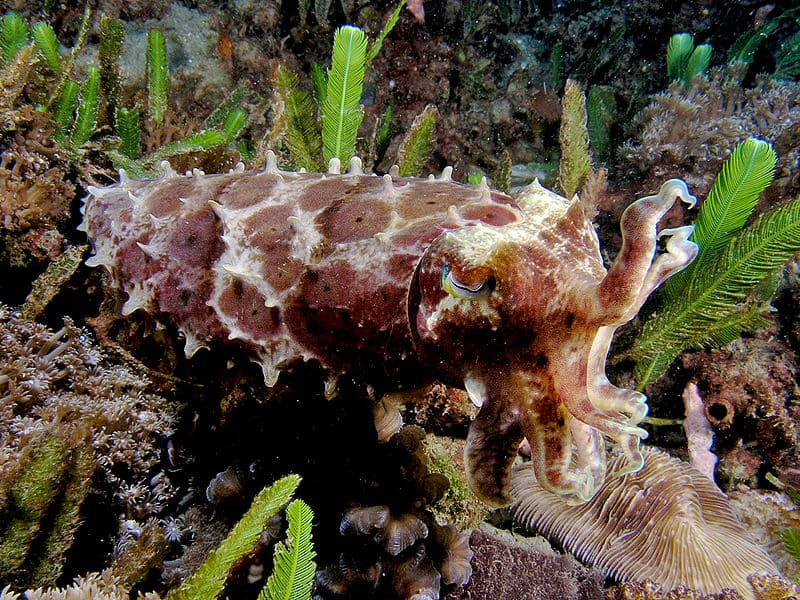
Cuttlefish have evolved to be masters of disguise.
Cuttlefish are some of the most ancient living creatures that swim the oceans today. Scientists believe the first cuttlefish began to emerge from their progenetors sometime 500 million years ago. Early cuttlefish greatly resembled their cousin the nautilus, being encased in a similar protective shell. Soon ancient cuttlefish began to develop the trait of camouflage, fine-tuning and perfecting their tactics for blending in with their environment for millions of years until shell was no longer necessary for their survival.
Cuttlefish are able to use their camouflage by activating the 20 million chromatosphores on their skin- these are specialized cells that control pigmentation. In addition to defending themselves from predators, cuttlefish have also evolved to use their color changing skin for communicating with other members of their species, with males often showcasing a complex pageant of color patterns in order to attract a mate.
Appearance and Behavior
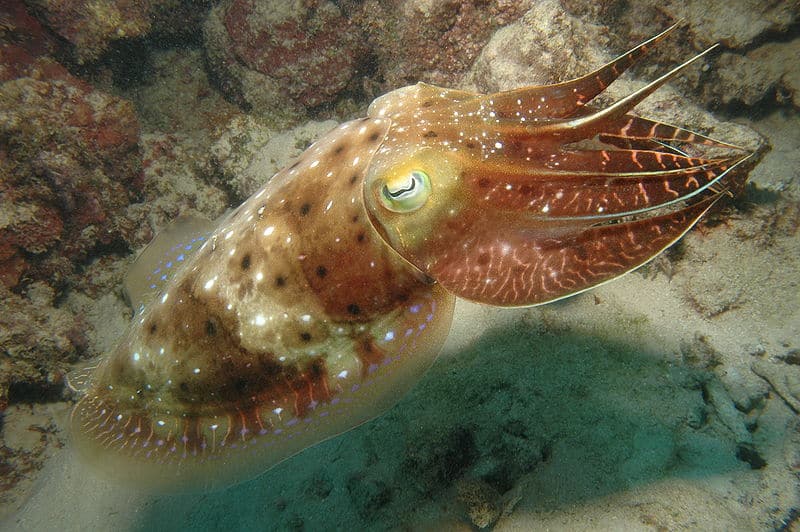
Cuttlefish have three hearts.
One look at this fish will tell you that it’s a true cephalopod. Its body resembles the closely related squid and octopus, except it is much smaller in size. The smallest cuttlefish species only measure an inch or two. The largest species is the Australian giant cuttlefish, which can measure up to 20 inches and weigh about 23 pounds.
The cuttlefish is characterized by the gas-filled internal cuttlebone (which actually provides buoyancy and control rather than protection), a long and relatively flat body, a parrot-like beak, and long fins running along both sides. It also features eight arms and two tentacles containing a series of suction pads that are used to capture prey. The arms and tentacles can be withdrawn into two pouches at any time. Cuttlefish are also one of the few animals that have multiple hearts. In total, they have three different hearts!
Two of those hearts supply blue-green blood to its gills while the third supplies oxygen to the rest of its body. Why is its blood blue-green instead of red?
Because cuttlefish blood contains hemocyanin which itself contains copper, rather than hemoglobin which contains iron.
The cuttlefish moves at incredible speeds through the water via jet propulsion. It does this by sucking in water through a body cavity and then expelling the water out with its powerful muscles. The fins allow it to maneuver at high speeds. This method of transportation is necessary to evade very fast and agile predators.
Another incredible ability is the color change. The cuttlefish body contains millions of small pigment cells called chromatophores that allow the creature to alter its color and pattern at any time. When the cuttlefish flexes its muscles, the pigment is released into the outer skin to blend in with the surroundings. This is used for many purposes such as to camouflage itself, attract mates, and communicate with other cuttlefish. The color change may also serve the purpose of stunning prey with quick and debilitating flashes.
The cuttlefish has a rather large brain-to-body size compared to most invertebrates. Studies reveal that it is capable of various degrees of problem-solving and object manipulation. This intelligence may be necessary to manipulate the incredibly complex tentacles and arms, which contain a large number of neurons like the brain.
Cuttlefish Distribution, Population, and Habitat
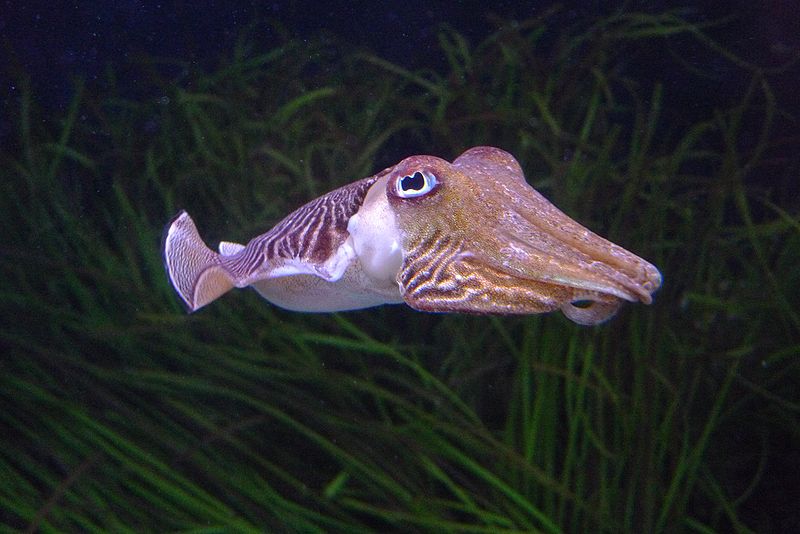
Cuttlefish are found around every continent but North and South America and Antarctica.
©David Sim from London, United Kingdom, CC BY 2.0, via Wikimedia Commons – License
The cuttlefish is found throughout the oceans and seas of Europe, Africa, Asia, and Australia, but it is largely absent from the Americas. Throughout its natural range, this animal exhibits a yearly migratory pattern. In the summer, it inhabits the coastal waters in tropical or temperate regions. In the winter, it migrates to the deeper water of the oceans.
According to the IUCN Red List, which keeps track of the conservation status of many animals, data about population numbers is unfortunately not available for many cuttlefish species. When data is known, almost all species are categorized as least concern. Only a few species are at risk of endangerment.
Diet
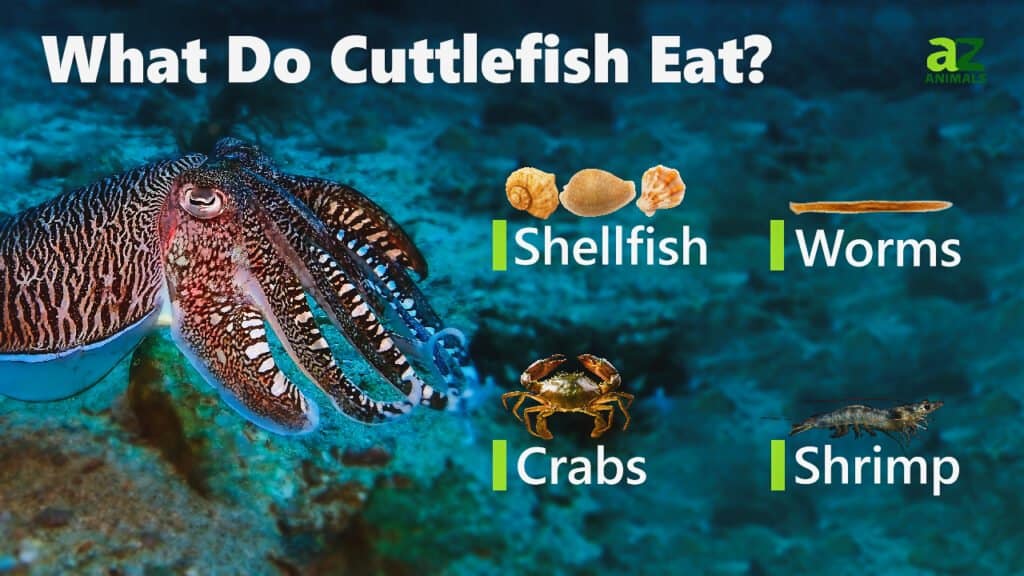
The cuttlefish has a rather simple diet consisting of fish, crab, and other mollusks. Larger cuttlefish also have the tendency to prey on juveniles or smaller species of cuttlefish. They use the beak located in the mantle between their arms to crack open the tough shells of their prey and feast on the tasty meat within. For a full analysis of what cuttlefish eat, we’ve published ‘What Do Cuttlefish Eat? The 10 Favorites of Their Diets.’
Cuttlefish Predators

Dolphins regularly feed on cuttlefish and other cephalopods.
©marshalgonz/Shutterstock.com
Due to its small size, the cuttlefish is hunted by all kinds of larger fish, dolphins, seals, birds, and other mollusks. But it does have several defensive mechanisms to help it survive. When threatened, the cuttlefish can release a cloud of ink to confuse predators and then make its daring escape. The speed is a distinct advantage over slower predators. The venom of some species also provides a valuable defense.
Reproduction and Lifespan

Cuttlefish usually only live 1-2 years.
The cuttlefish has a very organized and straightforward reproduction cycle. During the breeding season, which lasts between the spring and summer of every year, the male puts on a brilliant mating display in which it transforms colors and patterns to impress the female. Once accepted, the male uses its modified arm to transfer sperm into the female’s mantle near the mouth to fertilize the eggs.
The impregnated female then deposits 100 to 300 eggs at a time on rocks, seaweed, or other surfaces. She alone watches over the eggs until they hatch after a period of one or two months on average. Shortly after their duties are fulfilled, both the male and female will die, ceding the way to the next generation. Cuttlefish reach sexual maturity after a period lasting up to 18 months, but their life expectancy is a mere one or two years of age. This means they tend to perish after only a single mating season.
Cuttlefish in Fishing and Cooking
Cuttlefish is a popular dish throughout the coastal regions of Europe and East Asia. It is prepared in various ways: breaded, deep fried, grilled, or shredded. The ink can be served alone or with the rest of the cuttlefish as well.
Types of Cuttlefish
Earlier on we touched on some of the most notable species of cuttlefish, below you can find a comprehensive list of every type of this camoflauging cephalopod:
- Metasepia pfefferi (Flamboyant Cuttlefish)
- Metasepia tullbergi (Paintpot Cuttlefish)
- Sepia bartletti
- Sepia baxteri
- Sepia filibrachia
- Sepia mira
- Sepia plana
- Sepia senta
- Sepia subplana
- Sepia Elliptica (Ovalbone Cuttlefish)
- Sepia whitleyana
- Sepia aculeata (Needle Cuttlefish)
- Sepia brevimana (Shortclub Cuttlefish)
- Sepia esculenta (Golden Cuttlefish)
- Sepia lycidas (Kisslip Cuttlefish)
- Sepia prashadi (Hooded Cuttlefish)
- Sepia recurvirostra (Curvespine Cuttlefish)
- Sepia savignyi (Broadback Cuttlefish)
- Sepia smithi (Smith’s Cuttlefish)
- Sepia stellifera
- Sepia thurstoni
- Sepia vecchioni
- Sepia zanzibarica (Zanzibar Cuttlefish)
- Sepia australis (Southern Cuttlefish)
- Sepia omani (Oman Cuttlefish)
- Sepia sulcata (Grooved Cuttlefish)
- Sepia adami
- Sepia andreana (Andrea Cuttlefish)
- Sepia appelloefi
- Sepia arabica (Arabian Cuttlefish)
- Sepia aureomaculata
- Sepia bathyalis
- Sepia bidhaia
- Sepia braggi (Slender Cuttlefish)
- Sepia burnupi
- Sepia carinata
- Sepia confusa
- Sepia cottoni
- Sepia elongata
- Sepia erostrata
- Sepia foliopeza
- Sepia incerta
- Sepia ivanovi
- Sepia joubini
- Sepia kiensis
- Sepia kobiensis (Kobi Cuttlefish)
- Sepia koilados
- Sepia limata
- Sepia longipes (Longarm Cuttlefish)
- Sepia lorigera (Spider Cuttlefish)
- Sepia mascarensis
- Sepia mirabilis
- Sepia murrayi (Frog Cuttlefish)
- Sepia pardex
- Sepia peterseni
- Sepia rhoda
- Sepia saya
- Sepia sewelli
- Sepia sokotriensis
- Sepia subtenuipes
- Sepia tala
- Sepia tanybracheia
- Sepia tenuipes
- Sepia tokioensis
- Sepia trygonina (Trident Cuttlefish)
- Sepia vercoi
- Sepia vietnamica
- Sepia dubia
- Sepia faurei
- Sepia pulchra
- Sepia robsoni
- Sepia typica
- Sepia acuminata
- Sepia cultrata (Knifebone Cuttlefish)
- Sepia elegans (Elegant Cuttlefish)
- Sepia hedleyi (Hedley’s Cuttlefish)
- Sepia hieronis
- Sepia madokai (Madokai’s Cuttlefish)
- Sepia opipara
- Sepia orbignyana (Pink Cuttlefish)
- Sepia reesi
- Sepia rex
- Sepia vossi
- Sepia angulata
- Sepia apama (Giant Cuttlefish)
- Sepia bandensis (Stumpy-spined Cuttlefish)
- Sepia bertheloti (African Cuttlefish)
- Sepia chirotrema
- Sepia dollfusi
- Sepia elobyana (Guinean Cuttlefish)
- Sepia gibba
- Sepia hierredda (Giant African Cuttlefish)
- Sepia insignis
- Sepia irvingi
- Sepia latimanus (Broadclub Cuttlefish)
- Sepia mestus (Reaper Cuttlefish)
- Sepia novaehollandiae (New Holland Cuttlefish)
- Sepia officinalis (European Common Cuttlefish)
- Sepia papillata
- Sepia papuensis (Papuan Cuttlefish)
- Sepia pharaonis (Pharaoh Cuttlefish)
- Sepia plangon (Mourning Cuttlefish)
- Sepia plathyconchalis
- Sepia ramani
- Sepia rozella (Rosecone Cuttlefish)
- Sepia simoniana
- Sepia tuberculata
- Sepia vermiculata (Patchwork Cuttlefish)
- Sepiella cyanea
- Sepiella inermis (Spineless Cuttlefish)
- Sepiella japonica (Japanese Spineless Cuttlefish)
- Sepiella mangkangunga
- Sepiella ocellata
- Sepiella ornata (Ornate Cuttlefish)
- Sepiella weberi
Cuttlefish FAQs (Frequently Asked Questions)
What do cuttlefish eat?
The cuttlefish regularly consumes all kinds of fish, crab, and molluscs. It is not shy about consuming other species of cuttlefish as well.
What phylum do cuttlefish belong to?
The cuttlefish belongs to the phylum of mollusca. This is the second largest phylum of invertebrates (meaning animals that lack a spine) in the world. Approximately 85,000 living species of molluscs have been discovered in the major classes of snails, cephalopods, and bivalves.
Where do cuttlefish live?
The cuttlefish inhabits the coastal region of Europe, Africa, Asia, and Australia. They migrate out to the deep waters in the colder seasons.
Are cuttlefish dangerous to humans?
The humble cuttlefish poses almost no danger to humans. A few species can inject venom into their victims, but due to minimal contact with humans, this is not a significant risk.
Can you eat cuttlefish?
The cuttlefish is considered to be a delicacy in many parts of the world. Except for a few species which contain harmful compounds, almost all cuttlefish can be eaten.
What Kingdom do Cuttlefish belong to?
Cuttlefish belong to the Kingdom Animalia.
What class do Cuttlefish belong to?
Cuttlefish belong to the class Cephalopoda.
What phylum to Cuttlefish belong to?
Cuttlefish belong to the phylum Mollusca.
What family do Cuttlefish belong to?
Cuttlefish belong to the family Sepiida.
What order do Cuttlefish belong to?
Cuttlefish belong to the order Decapodiformes.
What type of covering do Cuttlefish have?
Cuttlefish are covered in Smooth skin.
What are some predators of Cuttlefish?
Predators of Cuttlefish include fish, sharks, and cuttlefish.
What are some distinguishing features of Cuttlefish?
Cuttlefish have long bodies and large eyes.
How many babies do Cuttlefish have?
The average number of babies a Cuttlefish has is 200.
What is an interesting fact about Cuttlefish?
Cuttlefish are found throughout the world’s oceans!
What is the scientific name for the Cuttlefish?
The scientific name for the Cuttlefish is Sepiida.
How many species of Cuttlefish are there?
There are 120 species of Cuttlefish.
How do Cuttlefish have babies?
Cuttlefish lay eggs.
What's the difference between cuttlefish and squid?
Cuttlefish are much smaller than squid, and they also have fans on either side of their head, which squids don’t typically have. Read all about their differences here!
How to say Cuttlefish in ...
Thank you for reading! Have some feedback for us? Contact the AZ Animals editorial team.
Sources
- Britannica, Available here: https://www.britannica.com/animal/cuttlefish
- Thought Co., Available here: https://www.thoughtco.com/facts-about-cuttlefish-2291937
- PBS (1970) https://www.pbs.org/wgbh/nova/camo/anat-nf.html Jump to top

















